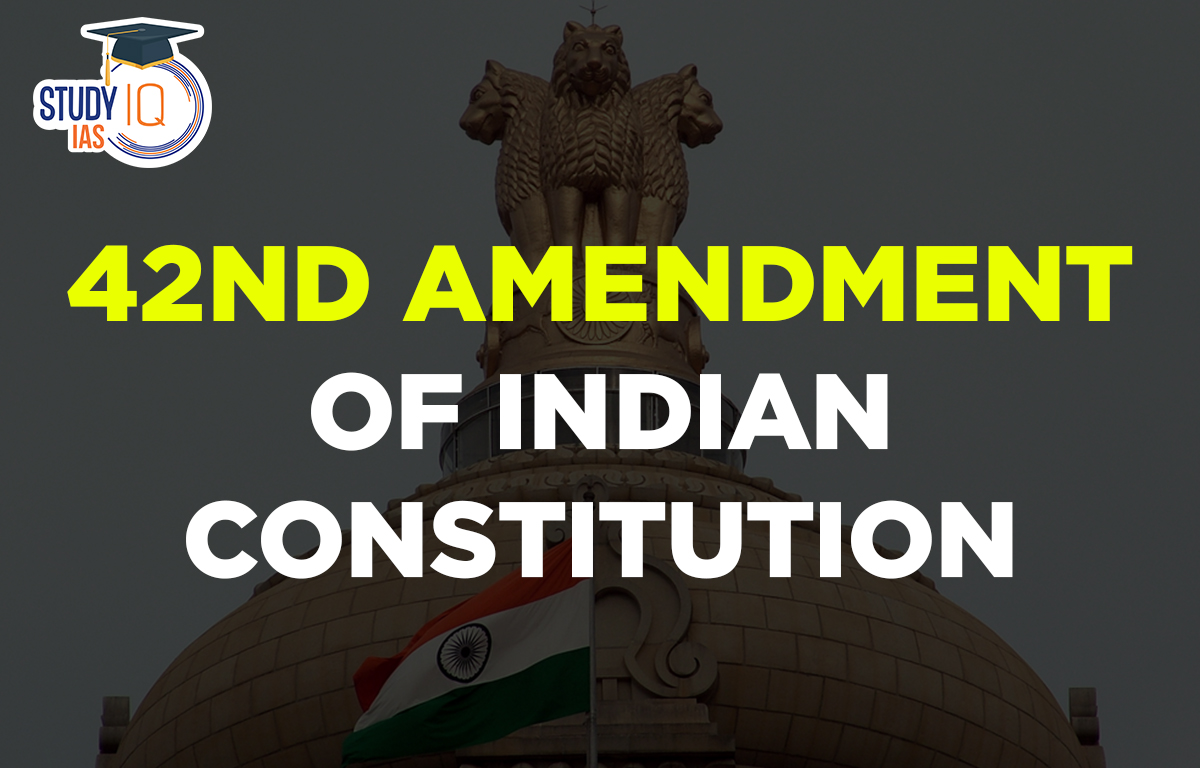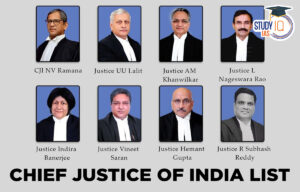Table of Contents
42nd Amendment of Indian Constitution 1976
On March 19, 1975, Indira Gandhi became the first Prime Minister to testify in court during her term regarding an election plea. This was also the first time since Independence that around 750,000 people, led by Jai Prakash Narayan, protested against her. Massive rallies were held nationwide, and public sentiment was strongly against her.
Indira Gandhi justified the need for emergency measures and revised several constitutional provisions, leading to the 42nd Amendment after changes made by the 40th and 41st Amendments.
On June 12, 1975, the Allahabad High Court annulled her election, and just days later, on June 25, the Emergency was declared. This marked the start of a period when the government began altering the fundamental nature of the Indian republic through constitutional amendments.
The Constitutional (Forty-second) Amendment Act of 1976 based on recommendations from the Swaran Committee. It amended the Preamble and changed 40 articles in the Constitution, including [article 31, article 31C, 39, 55, 74, 77, 81, 82, 83, 100, 102, 103, 105, 118, 145, 150, 166, 170, 172, 189, 191, 192, 194, 208, 217, 225, 226, 227, 228, 311, 312, 330, 352, 353, 356, 357, 358, 359, 366, article 368 and article 371F], Seventh Schedule and added 14 New Articles [articles 31D, 32A, 39A, 43A, 48A, 131A, 139A, 144A, 226A, 228A and 257A and parts 4A and 14A] to the Constitution.
The Constitution Act, 1976, also known as the 42nd Amendment Act, is a crucial component of the UPSC Political Science for the Prelims, Mains GS-II, as well as the Political Science optional papers, making it important for the IAS Exam.
Read about: Important Articles of Indian Constitution
42nd Amendment Act, 1976
The 42nd amendment to the Indian Constitution, the Constitutional Amendment Act of 1976, is well recognized for its contentious additions and modifications. The modifications were made in accordance with the recommendations provided by the Swaran Singh Committee, which Mrs. Indira Gandhi had established for the same purpose. The Preamble, 40 clauses, the Seventh Schedule, and 14 additional Articles that were added to the Constitution were all modified by this amendment.
| Changes by the 42nd Amendment Act | Amendment |
| Preamble |
|
| 7th Schedule | Transferred five subjects from the state list to the concurrent list:
|
| Article 51A | 10 Fundamental Duties added for the citizens. (The Fundamental Duties of citizens were added upon the recommendations of the Swaran Singh Committee that was constituted by the government in 1976) |
| Parliament |
|
| Judicial Powers of HC | Curtailed the judicial review power of the High Courts |
| Articles 323A and 323B, Part XIV-A | Part XIV-A added entitled as ‘Tribunals dealing with Administrative matters’ and ‘Tribunals for other matters’ |
| DPSPs | Three new DPSPs (Directive Principles of State Policy) were added to the existing list of DPSPs and one was amended:
|
It is important to note that while explaining every tiny modification would be impossible, let’s instead focus on all the significant changes that altered the public’s view of the Constitution, at least during the emergency period. Some of the significant changes brought about by this amendment include the following.
Preamble
The preamble is seen as a reflection of the Constitution. It has two main changes: “Sovereign Socialist Secular Democratic Republic” now replaces “Sovereign Democratic Republic,” and “unity and integrity of the nation” replaces “unity of the nation.” These changes sparked strong reactions in both legal and public circles, as they were viewed as a significant shift in how the Indian Constitution is presented globally.
Judicial Power
Before this change, the Union Legislature’s Acts could be challenged in court by High Courts, making it easy for the public to contest laws in their state. However, the amendment limited the High Courts’ power.
- Articles 226A and 228A now allow them to only rule on state laws.
- Article 131A was added to give the Supreme Court the exclusive authority to assess the legality of central laws.
- Articles 144A and 228A were introduced, sparking debate over judicial power.
Read about: Article 370
Suspension of the Fundamental Rights
Since the Constitution’s enactment, the people have continuously been granted their fundamental rights. The 42nd Amendment added provisions to the Constitution that allow for the suspension of fundamental rights during emergencies.
- Article 358 lets the government suspend the rights from Article 19 without notice when an external emergency is declared. This means Article 19 is suspended across the country for the duration of the emergency, and “emergency laws” are protected from legal challenges.
Induction of Fundamental Duties
The 42nd Amendment added Article 51A to the Constitution, outlining ten Fundamental Duties for Indian citizens. These duties include:
- Respecting the Constitution, the national flag, and the national anthem,
- promoting harmony,
- protecting the environment, and
- safeguarding public property.
The amendment aimed to encourage a sense of responsibility towards the nation, inspired by socialist constitutions.
DPSP
The amendment expanded the Directive Principles of State Policy in Part IV of the Constitution. It added new articles, like
- Article 39A, which requires the state to provide equal justice and free legal aid.
- Articles 43A and 48A were also included, promoting worker participation in industry management and environmental protection. These changes aimed to make state policies more inclusive and relevant to current social and economic needs.
Delimitation of Parliamentary Seats
The 42nd Amendment prevented changes to parliamentary constituency boundaries until after the first census in 2001, 26 years later. It also stopped the reallocation of reservations for women, SCs, and STs during that time. Before this amendment, Article 82 required redrawing constituency boundaries every 10 years after each census.
Extension of period of Parliament and State Legislative Assemblies
The amendment changed Article 172, extending the term of the Lok Sabha and State Legislative Assemblies from five to six years. This was said to promote stability in governance, but it faced criticism for delaying elections and undermining democratic norms.
Inclusion of Tribunals
The amendment created administrative tribunals to handle disputes and complaints about recruitment and service conditions for public employees at the Union and state levels.
- By adding Part XIV-A with Articles 323A and 323B, it aimed to ease the workload of regular courts and provide quicker resolution of disputes through specialized forums.
Legislative and Judicial Reactions
Following the state of emergency, nationwide general elections were held in 1977, and the Janata Party coalitions beat Congress. Mr. Morarji Desai served as the head of the newly established government, and their main responsibility was to restore the Constitution to its pre-emergency state. However, the new administration and legislature did not intend to roll back all of the Constitution’s amendments. As a result, the 42nd amendment was addressed by the 43rd and 44th Amendment Acts of 1977 and 1978, respectively. The High Courts and Supreme Courts now have the prior authority, “Internal Unrest” has been replaced with “Armed Rebellion,” and other important modifications have been made as a result of these amendments.
Read about: Constitution Day of India
42nd Amendment of Indian Constitution 1976
Even though this amendment is regarded as the most contentious in the history of the Indian Constitution, several of its provisions have remained in place for years and are still in force today because they are viewed as advantageous. For instance, it is thought to be desirable for both individuals and communities to have free legal aid policies, safeguard children and the environment, and uphold fundamental duties. But this amendment has a negative image with it because of its impact and a number of other factors.


 Justice BR Gavai will take oath as 52nd ...
Justice BR Gavai will take oath as 52nd ...
 Harnessing Spiritual Aastha for River Re...
Harnessing Spiritual Aastha for River Re...
 Daily Quiz 18 April 2025
Daily Quiz 18 April 2025





















